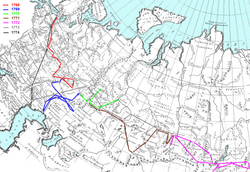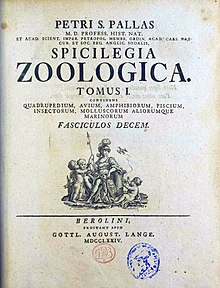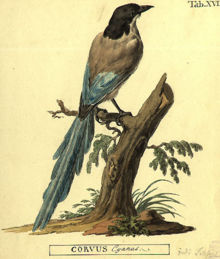Peter Simon Pallas
Peter Simon Pallas | |
|---|---|
University of Leiden | |
| Known for | Pallasite meteorite Elevation crater theory[1] |
| Scientific career | |
| Fields | Zoology Botany Geography Geology Ethnography Natural history Philology Taxonomy |
Peter Simon Pallas
Life and work

Peter Simon Pallas was born in
Pallas travelled throughout the Dutch Republic and to London, improving his medical and surgical knowledge. He then settled at The Hague, and his new system of animal classification was praised by Georges Cuvier[citation needed]. Pallas wrote Miscellanea Zoologica (1766), which included descriptions of several vertebrates new to science which he had discovered in the Dutch museum collections. A planned voyage to Southern Africa and the East Indies fell through when his father recalled him to Berlin. There, he began work on his Spicilegia Zoologica (1767–1780).

In 1767, Pallas was invited by
Pallas settled in

Between 1793 and 1794, Pallas led a second expedition to southern Russia, visiting the

In 1809 he became associate member of the Royal Institute of the Netherlands.[2]
Pallasite
In 1772, Pallas was shown a 680-kg lump of metal that had been found near Krasnoyarsk. Pallas arranged for it to be transported to St Petersburg. Subsequent analysis of the metal showed it to be a new type of stony-iron meteorite. This new type of meteorite was called pallasite after him; the meteorite itself is named Krasnojarsk or sometimes Pallas Iron (the name given to it by Ernst Chladni in 1794).
Commemorated
Several animals were described by Pallas, and his surname is included in their common names, including:
Also, he is honoured in the scientific names of animals described by others, including: the Dagestani tortoise (
He was also honoured in the name of a plant genus, Petrosimonia which is a genus of flowering plants belonging to the family Amaranthaceae.[4]
Streets in Berlin and Castrop-Rauxel are named Pallasstraße. Pallasovka, a city in Volgograd Oblast, is named after him, and his monument stands there.
An
Pallas was elected a member of the American Philosophical Society in 1791.[5]
Works


- Dissertatio inauguralis de infestis viventibus infra viventia (Leiden: Lugduni Batavorum, 1760).
- Elenchus zoophytorum, sistens generum adumbrationes generaliores et specierum cognitarum succinctas descriptiones, cum selectis auctorum synonymis (The Hague: van Cleef, 1766).
- Elenchus zoophytorum (in Latin). Den Haag: Franz Varrentrapp. 1766.
- Miscellanea zoologica, quibus novæ imprimis atque obscuræ animalum species describuntur et observationibus iconibusque illustrantur (The Hague, 1766).
- Spicilegia zoologica (in Latin). Vol. 1. Berlin: Gottlieb August Lange. 1774.
- Spicilegia zoologica (in Latin). Vol. 2. Berlin: Gottlieb August Lange. 1767.
- Spicilegia zoologica (in Latin). Vol. 3. Berlin: Gottlieb August Lange. 1767.
- Spicilegia zoologica (in Latin). Vol. 4. Berlin: Gottlieb August Lange. 1767.
- Spicilegia zoologica (in Latin). Vol. 5. Berlin: Gottlieb August Lange. 1769.
- Spicilegia zoologica (in Latin). Vol. 6. Berlin: Gottlieb August Lange. 1769.
- Spicilegia zoologica (in Latin). Vol. 7. Berlin: Gottlieb August Lange. 1769.
- Spicilegia zoologica (in Latin). Vol. 8. Berlin: Gottlieb August Lange. 1770.
- Spicilegia zoologica (in Latin). Vol. 9. Berlin: Gottlieb August Lange. 1772.
- Spicilegia zoologica (in Latin). Vol. 10. Berlin: Gottlieb August Lange. 1774.
- Spicilegia zoologica (Berlin, 1767—1780).
- Lyst der Plant-Dieren, bevattende de algemeene schetzen der geslachten en korte beschryvingen der bekende zoorten (Utrecht: van Paddenburg & van Schoonhoven, 1768).
- De ossibus Sibiriae fossilibus, craniis praesertim Rhinocerotum atque Buffalorum, observationes (Novi Commentarii Academiae Scientiarum Imperialis Petropolitanae, XIII, Saint Petersburg, 1768).
- Naturgeschichte merkwürdiger Thiere (Berlin, 1769—1778).
- Dierkundig mengelwerk, in het welke de nieuwe of nog duistere zoorten van dieren, door naauwkeurige afbeeldingen, beschryvingen en verhandelingen opgehelderd worden (Utrecht: van Paddenburg & van Schoonhoven, 1770).
- Reise durch verschiedene Provinzen des Russischen Reichs (Saint Petersburg, 1771—1801).
- Merkwürdigkeiten der Morduanen, Kasaken, Kalmücken, Kirgisen, Baschkiren etc., Frankfurt & Leipzig, 1773–1777, 3 vol.
- Puteshestviye po raznym provintsiyam Rossiyskogo gosudarstva (Saint Petersburg, 1773—1788).
- Flora Rossica (Saint Petersburg, 1774–1788, in 2 parts).
- Sammlungen historischer Nachrichten über die mongolischen Völkerschaften. St. Petersburg, Frankfurt, Leipzig 1776–1801.
- Observations sur la formation des montagnes et sur les changements arrivés au Globe, particulièrement à l'Empire de Russie (Acta Academiae Scientiarum Imperialis Petropolitanae, Saint Petersburg, 1777).
- Novae species Quadrupedum e Glirium ordine (Erlangen, 1778).
- Mémoires sur la variation des animaux (Acta Academiae Scientiarum Imperialis Petropolitanae, Saint Petersburg, 1780).
- Katalog rasteniyam, nakhodyashchimsya v Moskve v sadu yego prevoskhoditel'stva deystvitel'snogo statskogo sovetnika i Imperatorskogo Vopitatel'nogo doma znamenitogo blagodetelya, Prokofiya Akinfiyevich Demidova, sochinyonnyy P. S. Pallasom, adademikom sankt-peterburgskim (Saint Petersburg, 1781).
- Icones Insectorum praesertim Rossiae Sibiriaeque peculiarium (Erlangen, 1781–1806, in 4 issues).
- Opisaniye rasteniy Rossiyskogo gosudarstva, s ikh izobrazheniyami (Saint Petersburg, 1786).
- Sravnitel'nyye slovari vsekh yazykov i narechiy, sobrannyye desnitsey Vsevysochayshey osoby imperatritsy Yekateriny II (Saint Petersburg, 1787–1789, in 2 volumes).
- Tableau physique et topographique de la Tauride (Nova Acta Academiae Scientiarum Imperialis Petropolitanae, X, Saint Petersburg, 1792).
- Kratkoye fizicheskoye i topograficheskoye opisaniye Tavricheskoy oblasti (Saint Petersburg, 1795).
- Bemerkungen auf einer Reise in die südlichen Statthalterschaften des Rußischen Reichs in den Jahren 1793 und 1794 (Leipzig, 1799—1801)
- Species Astragalorum descriptae et iconibus coloratis illustratae (Leipzig, 1800).
- Travels through the southern provinces of the Russian Empire (London, 1802, in 2 volumes).
- Illustrationes plantarum imperfecte vel nondum cognitarum (Leipzig, 1803).
- Zoographia rosso-asiatica (Saint Petersburg, 1811, in 3 volumes).
References
- ISBN 0-471-103764.
- ^ "Peter Simon Pallas (1741–1811)". Royal Netherlands Academy of Arts and Sciences. Retrieved 19 July 2015.
- ^ ISBN 978-1-4214-0135-5. ("Pallas", p. 199).
- ^ "Petrosimonia Bunge | Plants of the World Online | Kew Science". Plants of the World Online. Retrieved 19 May 2021.
- ^ "Peter S. Pallas". American Philosophical Society Member History. American Philosophical Society. Retrieved 16 December 2020.
- ^ International Plant Names Index. Pall.
See also
Further reading
- Mearns, Barbara and Richard – Biographies for Birdwatchers
- Sherborn, C. Davies (1905). "The new species of birds in Vroeg's catalogue, 1764". Smithsonian Miscellaneous Collections. 47: 332–341.
- Stone, Witmer (1912). "Vroeg's catalogue". Auk. 29 (2): 205–208. JSTOR 4071356.
- Van Oort, E.D. (1911). "On the catalogue of the collection of birds brought together by A. Vroeg". Notes from the Leyden Museum. 34: 66–69.
External links
- Elenchus Zoophytorum Sistens Generum Adumbrationes Generaliores Et Specierum Cognitarum Succinctas and Lyst der plant-dieren, bevattende de algemeene schetzen der geslachten en korte beschryvingen der bekende zoorten, met de bygevoegde naamen der schryveren at GDZ Göttingen (archived 30 August 2007)
- Zoographia Rosso-Asiatica Volume 1 Volume 2 Volume 3
- About Pallas's cats (archived 11 September 2016)
